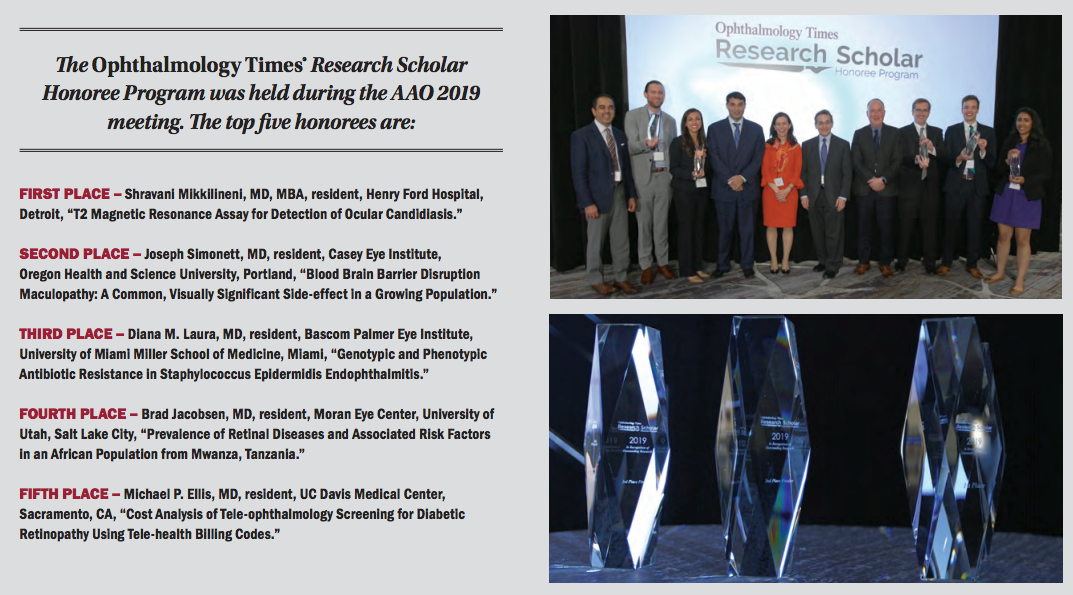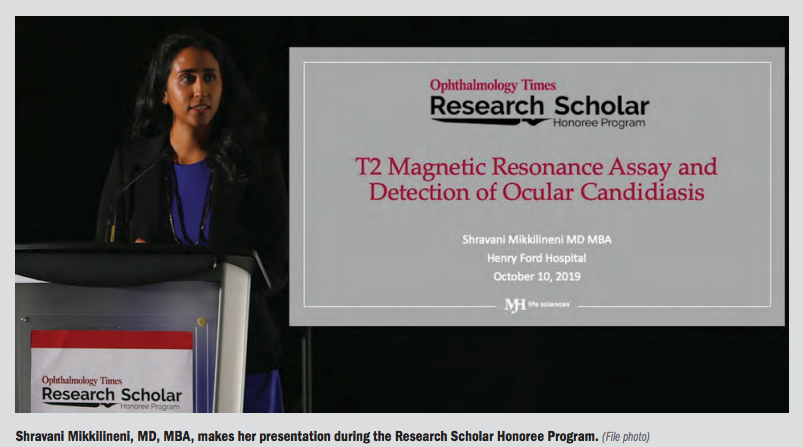News
Article
Third annual Research Scholar Honoree Program draws global interest
Author(s):

Fifteen fellows and residents showed just why research in retina is on the cutting edge
Editor's note: The Ophthalmology Times® Research Scholar Honoree Program is dedicated to the education of retina fellows and residents by providing a unique opportunity for fellows and residents to share notable research and challenging cases with their peers and mentors. The program is supported by an unrestricted grant from Regeneron Pharmaceuticals. The top five finalists were honored during a special program held by Ophthalmology Times® on the eve of the 2019 meeting at the American Academy of Ophthalmology.
The third annual Ophthalmology Times® Research Scholar Honoree Program featured a wide range of research topics, from a quantitative analysis of lamellar macular holes to the incidence and features of uveal melanoma to the 20-year incidence of macular telangiectasia type 2.
Chair Rishi P. Singh, MD, Cole Eye Institute, said while the program “has built upon itself” year after year, he’s been particularly impressed with the science and quality of abstracts submitted this year, especially those that incorporated big data.

“Whereas we used to see studies with 40 or 50 patients, we’re now seeing them with 50,000 or 100,000 from a series of registries or other collections of groups of patients over time,” Dr. Singh said.
The judges also noted they are starting to see the distinction of being a Research Scholar Finalist listed on incoming résumés. Dr. Singh and fellow judges Thomas A. Albini, MD, Bascom Palmer Eye Institute; Sophie J. Bakri, MD, Mayo Clinic; Andrew A. Moshfeghi, MD, MBA, Roski Eye Institute; and keynote speaker Philip J. Rosenfeld, MD, PhD, Bascom Palmer Eye Institute, University of Miami Miller School of Medicine, had pre-selected 15 presenters from among more than 90 entrants.
Each presenter was allowed 7 minutes to discuss their research, including what role they played in the research; the remaining 3 minutes were left for questions and answers with the judges.
“Congratulations on your research endeavor and thank you for trying to make a contribution to our field,” Dr. Singh said. “You put forward effort and passion to find insights into disease mechanisms and better treatments for our patients.”
Winning presentation
This year’s winner, Shravani Mikkilineni, MD, MBA, resident, Henry Ford Hospital, presented on T2 Magnetic Resonance Assay for Detection of Ocular Candidiasis.
“The Infectious Disease Society of America guidelines still recommend that candidemia patients have a dilated fundus exam within one week of identification,” she said.
Dr. Mikkilineni noted that fungal blood cultures are currently the gold standard for diagnosing candidemia, but they can take 1-8 days for positive culture growth of Candida species, and false negatives can be as high as 50%, especially in the setting of antifungal use.
“In most cases, a negative result is now confirmed 4-5 days after collection,” she said.
A new approach
Dr. Mikkilineni also explained that the T2 Magnetic Resonance assay (T2MR) is a newer nano-diagnostic FDA-approved approach to detect amplified DNA of Candida species from whole blood specimens, with a reported sensitivity of 89-98%, she said.
Dr. Mikkilineni’s research evaluated whether the T2MR was superior to traditional blood cultures in detecting the ocular complications of candidemia, namely infectious chorioretinitis and endophthalmitis.
Of the 277 patients included in the study, 275 had blood culture testing and 245 had T2MR testing. Thirty-three patients (12%) had definite ocular Candida infections.
Of these patients, 30 patients had chorioretinitis and three had endophthalmitis.
Of the patients, “178 were blood-culture positive for Candida and 185 were T2MR positive for Candida. So our most notable finding was that the sensitivity of our T2MR test was 83% for those patients with definite chorioretinitis as compared to 47% for blood cultures (P=0.016),” she said.
As the device is not at every hospital, it’s unclear what kind of clinical impact it may have for patients and those ordering the tests, she said.
The remaining top five finalists (in alphabetical order):
Michael P. Ellis, MD, resident, UC Davis Medical Center, Cost Analysis of Tele-ophthalmology Screening for Diabetic Retinopathy Using Tele-health Billing Codes;
Brad Jacobsen, MD, resident, Moran Eye Center, University of Utah, Prevalence of Retinal Diseases and Associated Risk Factors in an African Population from Mwanza, Tanzania;
Diana M. Laura, MD, resident, Bascom Palmer Eye Institute, University of Miami Miller School of Medicine, Genotypic and Phenotypic Antibiotic Resistance in Staphylococcus Epidermidis Endophthalmitis; and
Joseph Simonett, MD, resident, Casey Eye Institute, Blood Brain Barrier Disruption Maculopathy: A Common, Visually Significant Side-effect in a Growing Population.
Becoming a clinical researcher
Keynote presenter Dr. Rosenfeld advised attendees to choose research that targets an unmet need.
“Even better, match your research with your scientific interests,” he said, “but bear in mind your interests must evolve.”
Success will depend on a researcher’s ability to recruit for clinical trials, Dr. Rosenfeld said.
“There is no such thing as a quick and easy project,” he said. “Never forget your control arm.”
While retrospective subgroup analyses from prospective studies are necessary, “they should never be believed,” he said. “They’re useful for generating hypotheses, or confirming prior practices, but they need to be validated in prospective studies.”
If a phase 2 study is successful, “never change the protocol before the phase 3, and if the phase 2 study is unsuccessful, never design a phase 3 based on retrospective subgroup analysis,” he said.
As researchers become greater experts in a particular area, “people will seek you out to get your opinion. You’ll be exposed to novel ideas, treatments, and research projects,” Dr. Rosenfeld said.
Finally, he advised newer researchers to “Embrace the challenge of clinical research by asking the important questions. Go where the clinical need is greatest.” And, quoting Galaxy Quest, “Never give up-never surrender!”
About the Research Scholar Program Ophthalmology Times® requested ophthalmic institutions to nominate fellows and residents involved in unique and notable research related to some aspect of retinal disease.
Those who qualified were asked to submit an abstract and a 100-word summary of their work, plus prepare a presentation to include what the research contributes to the retinal community.
Supported by an unrestricted grant from Regeneron Pharmaceuticals, the top 5 finalists will be featured in a supplement to a peer-reviewed journal, and each received the Crystal Award.
All the presenters will have their research highlighted throughout the year in Ophthalmology Times® and online at OphthalmologyTimes.com.
“These research programs are really foundational to making the next big step in our field to improve our patients’ lives and improve the lives of our caregivers,” Dr. Singh concluded.
Newsletter
Don’t miss out—get Ophthalmology Times updates on the latest clinical advancements and expert interviews, straight to your inbox.




